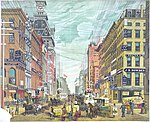Pearl Street (Manhattan)
Beaches of New York (state)Financial District, ManhattanNew York City road stubsPiers in New York CityShell middens in the United States ... and 2 more
Source attributionStreets in Manhattan

Pearl Street is a street in the Financial District in Lower Manhattan, running northeast from Battery Park to the Brooklyn Bridge with an interruption at Fulton Street, where Pearl Street's alignment west of Fulton Street shifts one block south of its alignment east of Fulton Street, then turning west and terminating at Centre Street.
Excerpt from the Wikipedia article Pearl Street (Manhattan) (License: CC BY-SA 3.0, Authors, Images).Pearl Street (Manhattan)
Pearl Street, New York Manhattan
Geographical coordinates (GPS) Address Nearby Places Show on map
Geographical coordinates (GPS)
| Latitude | Longitude |
|---|---|
| N 40.707095987642 ° | E -74.006275853283 ° |
Address
Courtyard & Residence Inn by Marriott
Pearl Street 215
10038 New York, Manhattan
New York, United States
Open on Google Maps








